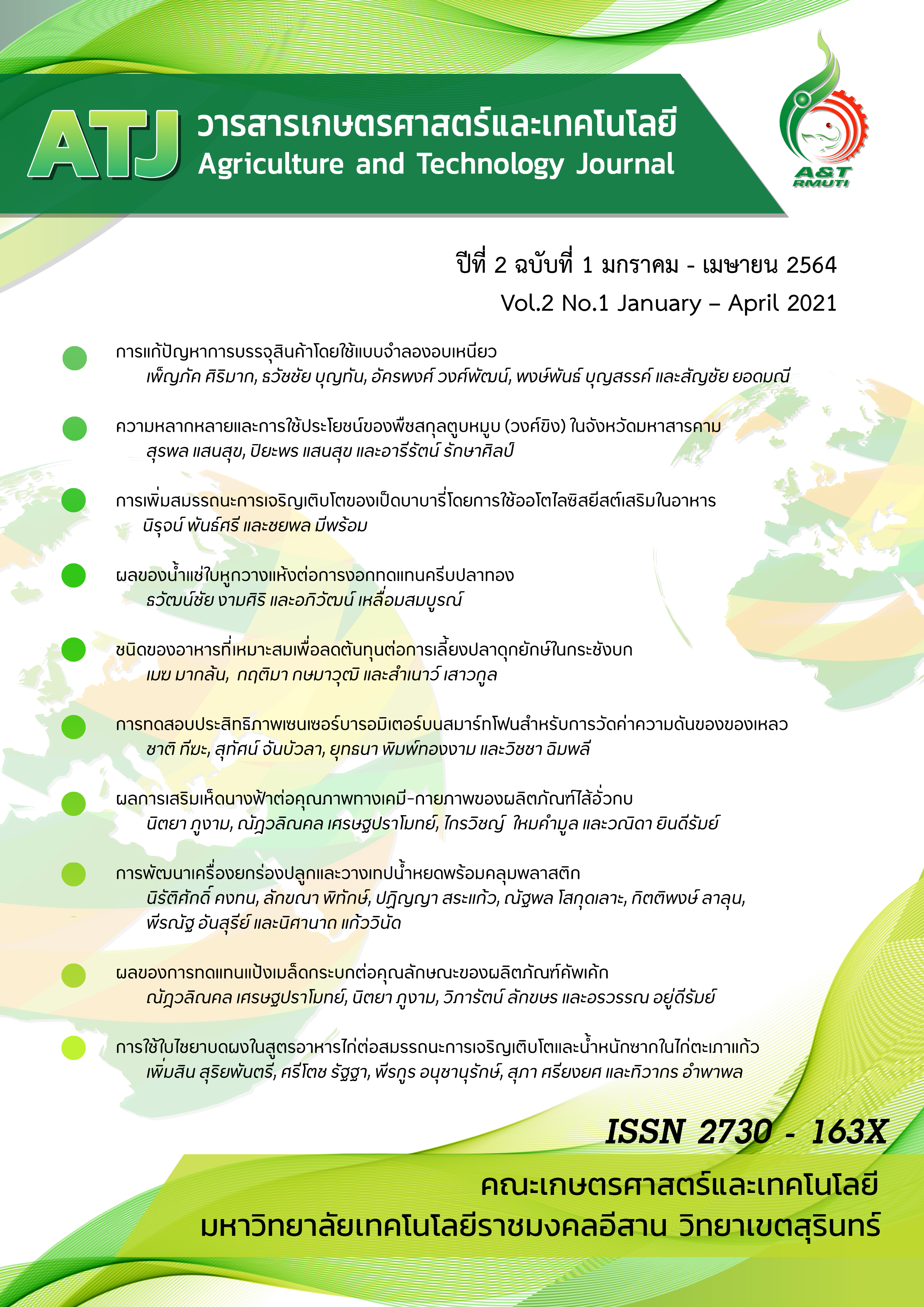การเพิ่มสมรรถนะการผลิตและผลตอบแทนทางเศรษฐกิจของเป็ดบาบารี่โดยการใช้ออโตไลซิสยีสต์เสริมในอาหาร
คำสำคัญ:
เป็ดเนื้อ, ออโตไลซิสยีสต์, สมรรถนะการผลิต, ผลตอบแทนทางเศรษฐกิจบทคัดย่อ
แนวโน้มของการใช้พรีไบโอติกเพื่อทดแทนการใช้ยาปฏิชีวนะในอุตสาหกรรมการเลี้ยงสัตว์มีการขยายตัวเพิ่มมากขึ้น มีการนำผลพลอยได้หรือผลผลิตร่วมจากโรงงานอุตสาหกรรมเกษตรที่มีคุณสมบัติในการเป็นพรีไบโอติกสำหรับสัตว์มาใช้โดยคาดหวังให้สัตว์มีการเจริญเติบโตที่ดีซึ่งออโตไลซิสยีสต์เป็นหนึ่งในพรีไบโอติกที่ได้มีการศึกษาถึงคุณสมบัติในการช่วยให้สัตว์มีการเจริญเติบโตที่ดี วัตถุประสงค์ของงานวิจัยนี้จึงศึกษาการนำออโตไลซิสยีสต์เสริมในอาหารของเป็ดบาบารี่ต่อสมรรถนะการเจริญเติบโต โดยใช้เป็ดบาบารี่คละเพศอายุ 10 วัน น้ำหนักตัวเฉลี่ย 59.03±5.86 กรัม จำนวน 96 ตัว ถูกนำมาจัดแผนการทดลองแบบสุ่มสมบูรณ์โดยแบ่งออกเป็น 4 กลุ่ม 4 ซ้ำ ๆ ละ 6 ตัว ประกอบด้วยกลุ่มควบคุมและกลุ่มที่เสริมออโตไลซิสยีสต์ที่ระดับ 0.1 0.2 และ 0.3 เปอร์เซ็นต์ในอาหาร ระยะเวลาการทดลองออกเป็น 4 ช่วง คือช่วงที่ 1 สัปดาห์ที่ 1-2 ช่วงที่ 2 สัปดาห์ที่ 3-4 ช่วงที่ 3 สัปดาห์ที่ 5-6 และช่วงที่ 4 สัปดาห์ที่ 7-8 ผลการทดลองพบว่าในช่วงสัปดาห์ที่ 2 การเสริมออโตไลซิสยีสต์ที่ระดับ 0.1 เปอร์เซ็นต์ มีแนวโน้มการเจริญเติบโตดีที่สุด (p<0.10) อย่างไรก็ตามเมื่อเสริมออโตไลซิสยีสต์มากกว่า 0.2 เปอร์เซ็นต์ พบว่ามีแนวโน้มของน้ำหนักตัวและน้ำหนักตัวที่เพิ่มขึ้นต่ำกว่ากลุ่มควบคุม การเสริมออโตไลซิสยีสต์ที่ 0.1 เปอร์เซ็นต์ ในช่วงสัปดาห์ที่ 5-6 พบว่ามีการเจริญเติบโตที่สูงสุดและมีการเปลี่ยนอาหารเป็นน้ำหนักตัวดีกว่ากลุ่มควบคุม (p<0.05) นอกเหนือจากนั้นยังพบว่าเป็ดบาบารี่ที่เสริมออโตไลซิสยีสต์ที่ระดับ 0.1 เปอร์เซ็นต์มีราคาในการจำหน่ายและกำไรสูงที่สุด (p<0.05) จึงสามารถสรุปได้ว่าปริมาณที่เหมาะสมต่อการเสริมออโตไลซิสยีสต์อยู่ที่ระดับ 0.1 เปอร์เซ็นต์ให้ผลต่อสมรรถนะการผลิตและผลตอบแทนทางเศรษฐกิจที่ดีที่สุด
เอกสารอ้างอิง
Aguilar‐Uscanga B. and Francois J.M. (2003). A study of the yeast cell wall composition and structure in response to growth conditions and mode of cultivation. Letters in applied microbiology. 37(3): 268-274.
Ahiwe E.U., Abdallh M.E., Chang E.P., Omede A.A., Al-Qahtani M., Gausi H., Graham H. and Iji P.A. (2020). Influence of dietary supplementation of autolyzed whole yeast and yeast cell wall products on broiler chickens. Asian-Australasian journal of animal sciences. 33(4): 579-587.
Ferket P.R., Parks C.W. and Grimes J.L. (2002). Mannan oligosaccharides versus antibiotics for turkeys. In the proceedings of Alltech's 18th Annual Symposium Nutritional biotechnology in the feed and food industries.: Nottingham University Press. Nottingham. 43-64.
Haldar S., Ghosh T.K. and Bedford M.R. (2011). Effects of yeast (Saccharomyces cerevisiae) and yeast protein concentrate on production performance of broiler chickens exposed to heat stress and challenged with Salmonella enteritidis. Animal feed science and technology. 168(1-2): 61-71.
Herre J., Gordon S., and Brown G.D. (2004). Dectin-1 and its role in the recognition of beta-glucans by macrophages. Molecular Immunology. 40(12): 869–876.
Iji P.A., Saki A.A. and Tivey D.R. (2001). Intestinal structure and function of broiler chickens on diets supplemented with a mannan oligosaccharide. Journal of the Science of Food and Agriculture. 81(12): 1186-1192.
National Research Council. (1994). Nutrient requirements of poultry. National Academies Press.
Orlean P. (2012). Architecture and biosynthesis of the Saccharomyces cerevisiae cell wall. Genetics. 192(3): 775-818.
Shurson G.C. (2018). Yeast and yeast derivatives in feed additives and ingredients: Sources, characteristics, animal responses, and quantification methods. Animal feed science and technology. 235: 60-76.
Sohail M.U., Ijaz A., Younus M., Shabbir M.Z., Kamran Z., Ahmad S., Anwar H., Yousaf M.S., Ashraf K., Shahzad A.H. and Rehman H. (2013). Effect of supplementation of mannan oligosaccharide and probiotic on growth performance, relative weights of viscera, and population of selected intestinal bacteria in cyclic heat-stressed broilers. Journal of Applied Poultry Research. 22(3): 485-491.
Spring P., Wenk C., Connolly A. and Kiers A. (2015). A review of 733 published trials on Bio-Mos®, a mannan oligosaccharide, and Actigen®, a secondgeneration mannose rich fraction, on farm and companion animals. Journal of Applied Animal Nutrition. 3: 1-11.
Vukašinović-Milić T., Rakin M. and Šiler-Marinković S. (2007). Utilization of baker's yeast (Saccharomyces cerevisiae) for the production of yeast extract: effects of different enzymatic treatments on solid, protein and carbohydrate recovery. Journal of the Serbian Chemical Society. 72(5): 451-457.
Yalçın S., Eser H., Cengiz S. and Eltan Ö. (2013). Effects of dietary yeast autolysate (Saccharomyces cerevisiae) on performance, carcass and gut characteristics, blood profile, and antibody production to sheep red blood cells in broilers. Journal of Applied Poultry Research. 22(1): 55-61.
Yang Y.I.N.G., Iji P.A., Kocher A., Thomson E., Mikkelsen L.L. and Choct M. (2008). Effects of mannan oligosaccharide in broiler chicken diets on growth performance, energy utilization, nutrient digestibility and intestinal microflora. British Poultry Science. 49(2): 186-194.
Zhang A.W., Lee B.D., Lee S.K., Lee K.W., An G.H., Song K.B. and Lee C.H. (2005). Effects of yeast (Saccharomyces cerevisiae) cell components on growth performance, meat quality, and ileal mucosa development of broiler chicks. Poultry science. 84(7): 1015-1021.
ดาวน์โหลด
เผยแพร่แล้ว
เวอร์ชัน
- 08-02-2024 (3)
- 26-04-2021 (2)
- 26-04-2021 (1)
รูปแบบการอ้างอิง
ฉบับ
ประเภทบทความ
สัญญาอนุญาต
ลิขสิทธิ์ (c) 2021 วารสารเกษตรศาสตร์และเทคโนโลยี

อนุญาตภายใต้เงื่อนไข Creative Commons Attribution-NonCommercial-NoDerivatives 4.0 International License.
เนื้อหาและข้อมูลในบทความที่ลงตีพิมพ์ในวารสารทดสอบระบบ ThaiJo2 ถือเป็นข้อคิดเห็นและความรับผิดชอบของผู้เขียนบทความโดยตรงซึ่งกองบรรณาธิการวารสาร ไม่จำเป็นต้องเห็นด้วย หรือร่วมรับผิดชอบใดๆ
บทความ ข้อมูล เนื่อหา รูปภาพ ฯลฯ ที่ได้รับการดีพิมพ์ในวารสารทดสอบระบบ ThaiJo2 ถือเป็นลิขสิทธิ์ของวารสารทดสอบระบบ ThaiJo2 หากบุคคลหรือหน่วยงานใดต้องการนำทั้งหมดหรือส่วนหนึ่งส่วนใดไปเผยแพร่หรือเพื่อกระทำการใดๆ จะต้องได้รับอนุญาตเป็นลายลักอักษรณ์จากวารสารทดสอบระบบ ThaiJo2 ก่อนเท่านั้น







